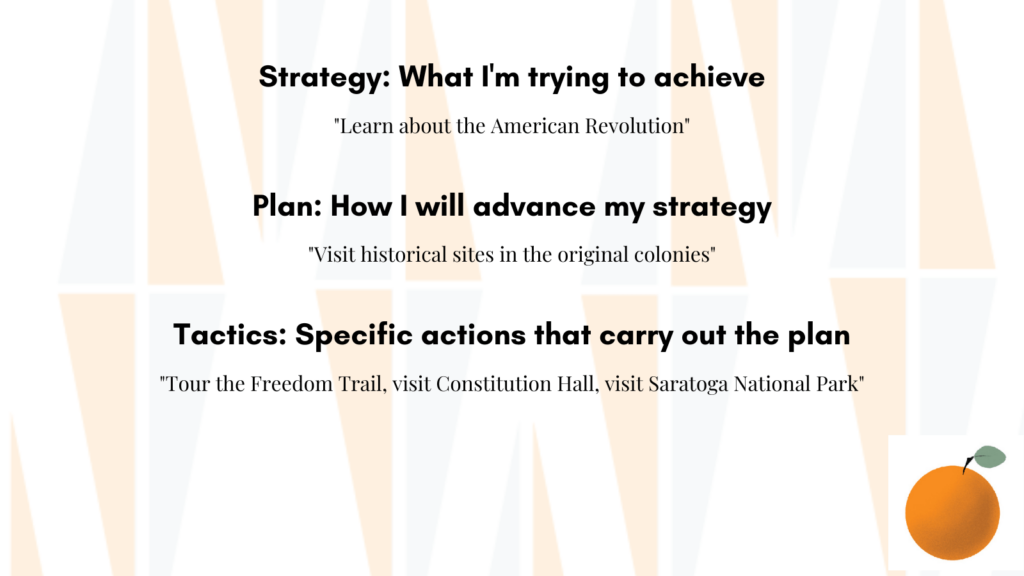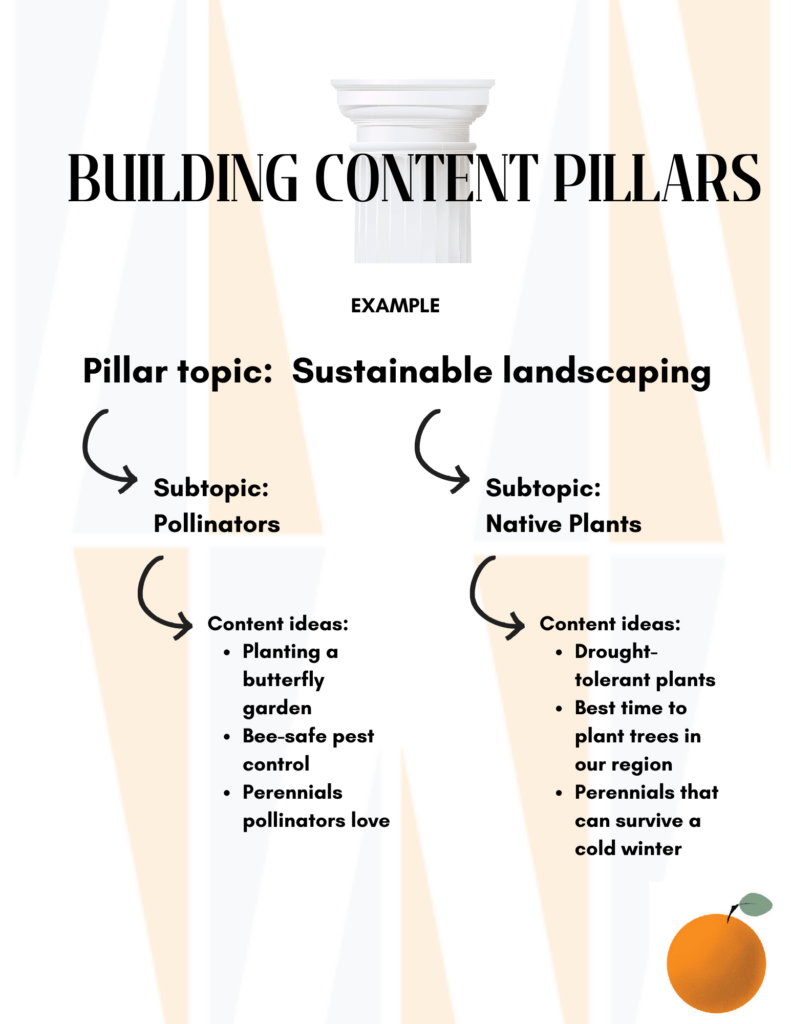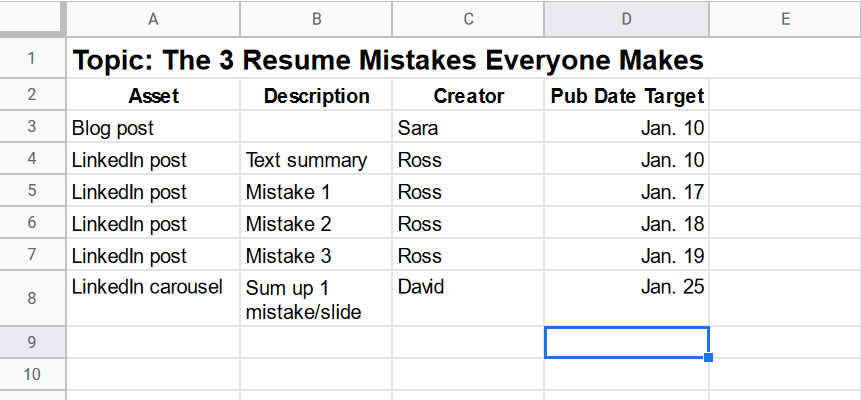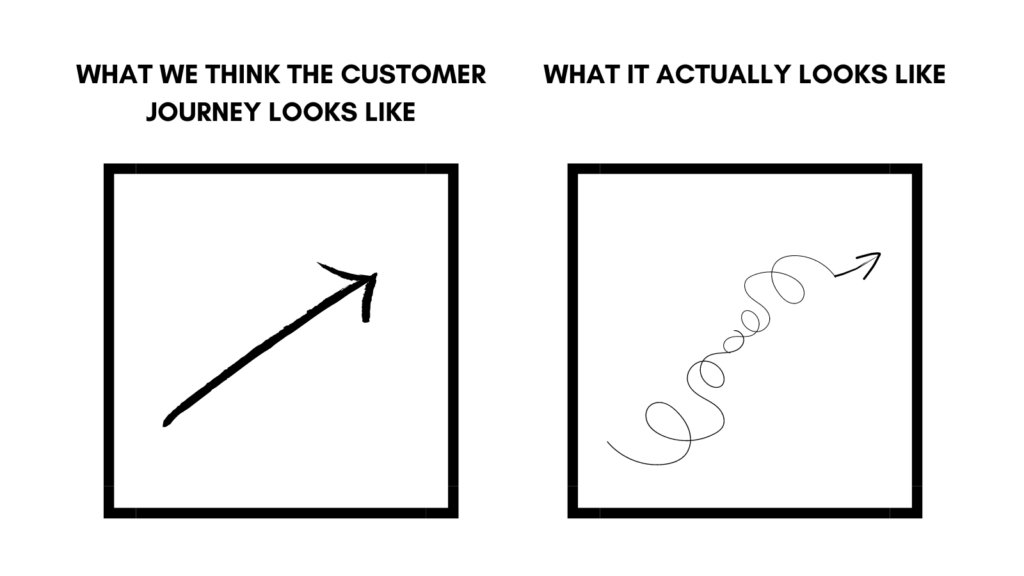This is a long one; estimated read time is around 13 minutes. If you’d like to save it to read later, you can download it as a PDF.
Content strategy might be the most widely misunderstood concept in marketing. In a lot of small businesses, it looks something like this:
Post 1 blog per month
Send 2 emails per month
Post 5x per day to LinkedIn, etc., etc.
A schedule like that is important. But it’s not a content strategy.
It might keep you consistent, but it also keeps you running on a hamster wheel of creating content that has no purpose other than showing up.
Lots of effort. Little impact. Not very strategic. 😕
A real content strategy is a map that marks where you are, where you’re going, and the route to get there. It’s backed up by a content plan, the travel itinerary that lists the steps you’ll take along your journey.
A publishing schedule is one of those steps. But it’s a tiny one that comes near the end. We have a whole lot of strategizin’ to do first.
Here’s how.
Table of Contents
Content strategy, content plan, content tactics – they’re not the same
Vocabulary’s a big reason for all this confusion. People say “strategy” when they mean “plan” or “tactics.”
“Tour the Freedom Trail in Boston” is a tactic. It could be part of a plan to “visit historic sites” that advances a strategy of “learn about the American Revolution.”
Likewise, “send 2 emails per month” is a tactic. It might be part of a plan to “teach subscribers why this topic is important,” advancing a strategy of “generate leads for consulting.”

What’s a content strategy?
A content strategy ties your content back to your business goals – like writing an email to generate leads, not just because it’s the first of the month. This gives more impact to your efforts. It keeps you off the hamster wheel because your content has a purpose.
A strategy helps you create content your audience can use. Content that connects what they want back to what you do. Content that builds your brand and moves your business forward.
That’s what you should spend time building.
What goes into a content strategy?
When I’m building a strategy, here are the basic elements I look for. 👇 Some might already be documented in another place, like a business plan. If so, great. When those foundational pieces carry through multiple parts of the business, it’s a good sign everyone is pulling in the same direction.
- Brand vision, mission, and values. Why does your business exist (outside of making money)? What values are important to you?
This isn’t a nice-to-have. Having these things defined and documented ensures your content reflects who you are. - Your brand story. Record where you came from. What visions, desires, and actions led your company to where it is today? Your content should reflect that journey. This – not using slang or cussing a lot – is how you “humanize” your brand so audiences relate to it.
- Audience. Who are you trying to reach? What’s important to them? What do they want? What’s their pain? Where do they hang out? What do you need to prove before they find you credible?
You can create the most perfect content in the world, but if no one who might do business with you sees it, it was a waste of time.
PRO TIP: A great strategy takes this beyond theoretical personas. It includes audience research and real voice-of-customer quotes. Content is conversation at scale, and what you hear in a conversation is as important as what you say.
- Your uniqueness. What makes you different from everyone else solving the same problem you solve? Why should your customers care about that and choose you over them?
- Goals. Why are you even creating content? How is it moving you closer to your marketing objectives?
For example, if you’re a financial planner and your marketing goal is to increase visibility among high net-worth individuals, your content goal might be to demonstrate your expertise in inheritance tax. - Challenges. What’s the state of your content right now? What obstacles do you have to overcome to achieve your goals?
For a small team, bandwidth might be a challenge. A lot of small businesses make an ambitious plan without considering whether they have enough people and enough time to carry it out. Other challenges might include a crowded marketplace or an audience unfamiliar with how your product works. - Metrics. When all is said and done, how will you measure success? How do you know if the content you put out there is working?
With all these questions answered, you have a map. You know where you are and where you want to be. Now – how do you get from here to there?
Your content plan puts your strategy in motion
Once your strategy is set, you’re ready for a content plan.
What’s the difference? A strategy maps out where you are and where you’re going. A plan is how to get there. It lists the tactics you’ll use and the timeline you’ll follow to reach your destination.

The more specific you can make your plan, the better. A travel itinerary that says, “Spend the night in a hotel” without specifying which hotel takes a pretty big gamble. You might end up with satin sheets, room service, and a mint on the pillow or with a mysteriously stained bedspread and six-legged roommates that scatter when you flip on the light.
That’s the kind of gamble you make when you create a plan that says “Write one blog post a month.” Some months you’ll be inspired and write 1,000 words of persuasive eloquence. Other months you’ll stare blankly at a blinking cursor, picking at a bit of dead skin on your thumb and wondering if it’s possible you’ve literally said everything there is to say about your business.
Don’t risk it. Be specific and intentional in your planning. Want to write a monthly blog? Plan 12 topics that connect back to your content strategy. If you develop more than 12, even better – now you have an overflow list of ideas to develop for the future.
Planning that far ahead doesn’t prevent you from addressing timely topics that come up in the meantime. You could address those topics by adding more posts to your cadence (no one’s going to get mad if you write 15 blog posts in a year instead of 12). Or you could cover the timely topic instead and bump the rest of your planned posts out a month.
This kind of plan lets you work from a place of abundance. You’ll never have to scramble for “what to talk about next” because you’ve already thought of that. Even on days when you’re tired and uninspired and the muse is a no-show, you can still create.
A content plan maximizes your content ROI in two ways. First, as I just demonstrated, it saves you time. Gold star for efficiency. 🌟
Second, it helps you squeeze more value out of content once it’s created. Your plan includes ways each piece can be repurposed into other media. When you build your timeline, schedule regular audits to review and optimize old content so it continues to serve you.
Putting in the time and energy to develop a solid plan before creating content means over time, every piece will work more efficiently for you.

How often should you update your content strategy?
You’ll notice all the parts of your content strategy are really foundational. They’re not going to change much in a short time. Update goals, challenges, and metrics annually. The rest will probably serve you for years unless you’re in a rapid-growth stage or a super fast-moving industry.
Content plans, on the other hand, should be reviewed at least twice a year. If you’re creating a lot of content, I’d suggest reviewing quarterly. Marketing is experimentation – things don’t always work the way you thought they would. These regular check-ins are a chance to double down on what’s effective and revise or abandon what flopped.
What small teams need to know before making a content plan
First, don’t cut corners. Start with a content strategy. You need a destination before you start mapping a route to get there.
Next, recognize the limits of your team. No matter how talented or how dedicated, there is only so much one person can do. Each phase of the content lifecycle – research, planning, creation, and maintenance – takes time.
If you don’t plan for that, you risk taking a detour to Burnout City. Or having a great plan that’s only half done. Or both.
There are three ways you execute a content plan without overburdening your small team.
- The most obvious option is to simply commit to a lighter cadence. Publish fewer pieces, but make them great and optimize the hell out of them.
- Alternatively, you could bring in a contractor to lighten the load. The most common choice is to hire a freelancer for content creation, while your team focuses on planning, distribution, and maintenance.
- If you have enough people, the most effective option is to share the load. Instead of one person owning a project all the way through, put them in charge of one phase of every project. For example, Jess handles research and planning, then sends a brief to Ann, who creates the piece and sends it to Eric for promotion. In that scenario, Jess is probably the content manager, so monitoring and maintenance fall under her domain, too.
OK, so you’ve got your map. You’ve got your crew. Now for the moment you’ve been waiting for – putting the rubber to the road and making your plan.

8 steps to making a content plan for a small team
1. Consider your goals
Reverse engineer the goals you came up with in your content strategy. For example, one of my strategic goals is to generate leads for my content guides. So I brainstormed:
Who is the ideal customer for this product?
How could it help them?
How do I demonstrate that value?
Where would they expect to find that kind of content?
If your goal is to establish yourself as a thought leader, your questions will be a little different. Same if your goal is brand awareness. Or sales enablement.
The smaller your team, the more important it is to focus on one or two goals. Don’t dilute your impact trying to be all things to all people.
For example, if you have a “how-to” blog that teaches practical skills, don’t post an opinionated thought leadership piece there. It’ll never find its audience. The audience that came looking for a tutorial and found projections on the future of the industry will just get annoyed.
PRO TIP: You can cover multiple bases by categorizing your content magazine style. For example, maybe you have a newsletter and podcast for your thoughts on the industry, and your blog and YouTube channel are focused on practical application.
Or you could turn your blog into a knowledgebase. For example, Colgate’s website is separated into sections like advice on healthy habits, information on common mouth ailments, and educational resources for kids. It’s a model that maintains a consistent experience by letting the audience choose their own adventure.
2. Consider your audience
Identifying your audience was part of developing your strategy. You need to know who you’re creating content for before you know what they want you to create.
(Read that again. Your content plan is never about what you want to create. It is always about what the audience wants to consume.)
Your plan should consider the topics your audience wants to know about, the formats they like to consume, and the trust factors that will make them believe you know what you’re talking about.
Don’t get caught in the trap of creating only top-of-funnel content. Once you’ve captured the interest of those top-of-funnel prospects, have content available that leads them farther along the path to what you ultimately want them to do. And don’t leave your current customers out in the cold – create content that supports people after they’ve drunk the Kool-Aid and bought from you.
3. Find your pillar topics
Your pillar topics are the core things your content will address. They’re the three or so topics that align with your goals, satisfy your audience, and position your brand in the market.
Beneath each pillar is a cluster of subtopics, and within those are your content ideas.
For example, a pillar topic for a landscaper might be “sustainable landscaping.” Under that pillar would be subtopics like “pollinators,” “native plants,” and “eco-friendly pest control.” Content ideas under “pollinators” could include “planting a butterfly garden,” “building a bee house,” and “how pesticides affect bees.”

4. Choose your channels
Plan how you’ll distribute your content. Include owned channels (like a blog or newsletter), social channels (paid and organic), and earned channels (like media mentions and guest posts).
When choosing a channel, first consider where your audience hangs out. You’ll know this from the audience research you did while building your strategy.
Also consider your own capabilities. Maybe your audience loves YouTube, but the thought of editing videos gives you hives. You have two real options: skip the channel or outsource the editing.
The third option – create video even though you hate it – is technically viable. But if the activity makes you miserable you probably won’t stick with it long enough to see results.
PRO TIP: Tailor your content to what the audience expects to see on your chosen channel. A beauty brand might have a tutorial that blows up Instagram but flops on LinkedIn, even if the target audience is female entrepreneurs.
Why? Because when that audience is on Instagram, they expect to see things that appeal to their personal interests. When they’re on LinkedIn, they expect to see things that aid their career.
If the beauty brand wants to experiment on LinkedIn, it should try posting things like inspiring stories of women on its exec team or thought leadership about makeup norms in the workplace.
5. Create your calendar
Here’s the moment you’ve been waiting for. Now you’re ready to plan out what content you’ll create, when, and where.
You can’t be everywhere, so prioritize. Maybe you’ll go for the low-hanging fruit and create the easiest content first, or maybe you’ll tackle the piece with the highest potential ROI.
For every piece you put on the calendar, include how, when, and where you’ll repurpose it. Assign each piece to a specific person on the team.
Here’s an example of how that might look:

Creating all the repurposed assets at once – even if you plan to spread out the distribution – is highly efficient. Get it all done and put that creation phase to bed.
When you first start, I suggest checking at the end of the first month to see if everything hit its deadline. Look for any bottlenecks in your process. If everything was done with time to spare, consider upping the cadence.
6. Assign creators
Assigning responsibility for each piece of content at the same time it goes on the calendar keeps you from burning out your team (or yourself, if you’re a team of one). You can see when someone has too much on their plate and either redistribute or outsource.
If you don’t have the internal resources to do all the things you want to do, now is the time to either adjust your scope or bring in help.
If you decide to bring in a contractor, decide who on your team will find and vet the contractor; who will be their point of contact; who will create the brief; and who will edit and publish the finished work.
7. Schedule audits
Once you have a library of content, you no longer have to create every new piece from scratch. A lot of content is forced into retirement when it still has value left.
Include time in your calendar for content audits. According to SEMRush’s State of Content Marketing 2022 Global Report, 65% of companies with successful content plans conduct audits more than twice a year.
Start with content that did well at first but has fallen off, content that’s just shy of hitting its goals, and content that has a high click rate but low time on page.
Look for thin information you can beef up, dated information you can refresh, confusing sections you can clarify, and a clear path to action.
8. Track performance
The success of your content depends on your goals for it. Before you start, pick something you can measure.
Sometimes you can directly attribute outcomes like sales and leads to content, which is great. But the customer journey isn’t linear and attribution’s not usually so cut and dried.

Other indicators you can use to track performance include things like views, social shares, engagement, time on page, and bounce rate.
Create a feedback loop so the audience response influences the next content plan. Put more energy toward what’s working and less toward what isn’t.
Look for trends among your most and least successful content. That will help you target the right places to push and pull back. Use trends to theorize why something succeeded or failed. Was it the topic? The format? The channel? Test your theory by tweaking just one thing and trying again.
Marketing is all about experimentation. We don’t always know exactly why one thing works and another fails. But following a plan to systemically create and track content means we can spot trends far easier than we could if we were churning out random pieces.
Stop committing random acts of content
I know this sounds like a lot. And compared to just posting whatever you feel like whenever the spirit moves you, it is.
But that’s what separates content from content marketing. If you expect content to pull its weight as an actual marketing activity, you have to enter into it with some deliberation.
Making and sharing content takes time and energy. I don’t know any small marketing team with an endless reservoir of either. A sound strategy and detailed plan uses the resources you have as efficiently as possible so you can expend less effort and get more impact.
